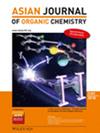铁催化硅氢化将亚胺化学选择性还原为N -烯丙基胺
IF 2.8
4区 化学
Q1 CHEMISTRY, ORGANIC
引用次数: 0
摘要
不饱和亚胺的化学选择性硅氢化反应是具有挑战性的,因为两个双键竞争的反应。在本文中,我们报道了铁催化的烯亚胺化学选择性硅氢化反应,导致在膦配体存在下生成烯丙胺。一种低价的Fe(0)配合物[(BDA)Fe(CO)3]在室温下催化了乙烯亚胺的硅氢化反应,并显示出广泛的底物范围,包括各种乙烯亚胺(肉桂亚胺,烯丙亚胺)和氯胺。机理研究表明,该反应通过硅烷化合物的氧化加成进行,导致氢化铁中间体的形成。随后,双电子途径促进了乙烯基底物的硅氢化。通过制备定义明确的铁(II) -硅烷配合物并将其用作催化剂控制,支持了这一点。基于实验和计算研究,提出了一种可行的Chalk - Harrod - type机制。本文章由计算机程序翻译,如有差异,请以英文原文为准。
Iron‐Catalyzed Chemoselective Reduction of Enimines to N‐Allylic Amines via Hydrosilylation
Chemoselective hydrosilylation of unsaturated imines is challenging as the two double bonds compete for the reaction. Here in, we report an iron‐catalyzed chemoselective hydrosilylation of enimines leading to the generation of allyl amines in the presence of phosphine ligand. A low‐valent Fe(0) complex [(BDA)Fe(CO)3] catalyzed the hydrosilylation of enimine at room temperature and exhibited broad substrate scope including a variety of enimine (cinnamylimine, allylimine) and ketimine. Mechanistic investigations revealed that the reaction proceeds through an oxidative addition of the silane compound, leading to the formation of an iron hydride intermediate. Subsequently, a two‐electron pathway facilitates the hydrosilylation of the enimine substrate. This has been supported by preparing a well‐defined Fe(II)‐silane complex and using it as a catalyst control. Based on experimental and computational investigations, a plausible Chalk‐Harrod‐type mechanism is proposed.
求助全文
通过发布文献求助,成功后即可免费获取论文全文。
去求助
来源期刊

Asian Journal of Organic Chemistry
CHEMISTRY, ORGANIC-
CiteScore
4.70
自引率
3.70%
发文量
372
期刊介绍:
Organic chemistry is the fundamental science that stands at the heart of chemistry, biology, and materials science. Research in these areas is vigorous and truly international, with three major regions making almost equal contributions: America, Europe and Asia. Asia now has its own top international organic chemistry journal—the Asian Journal of Organic Chemistry (AsianJOC)
The AsianJOC is designed to be a top-ranked international research journal and publishes primary research as well as critical secondary information from authors across the world. The journal covers organic chemistry in its entirety. Authors and readers come from academia, the chemical industry, and government laboratories.
 求助内容:
求助内容: 应助结果提醒方式:
应助结果提醒方式:


